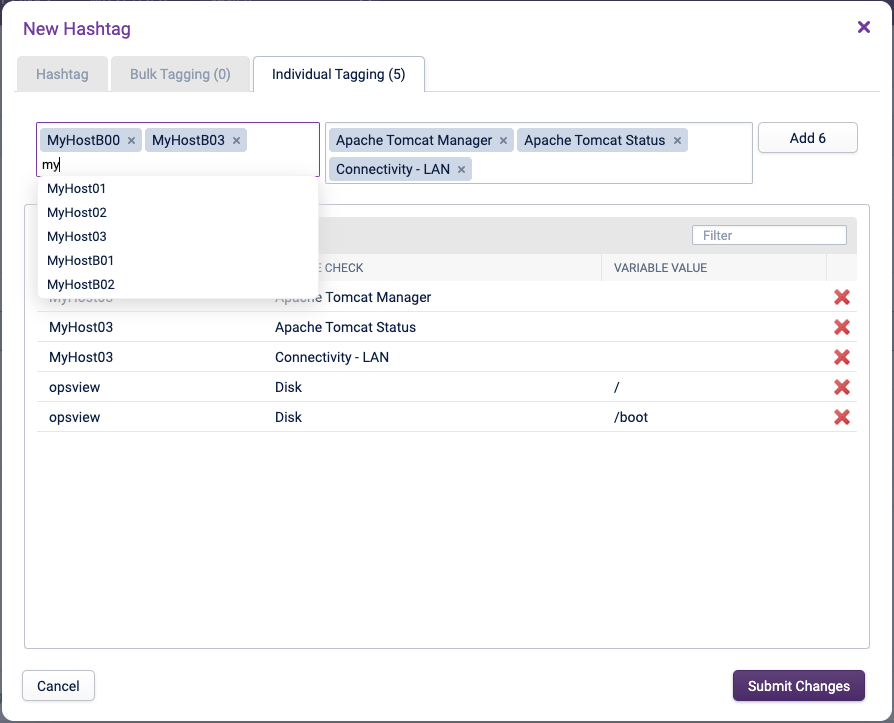Adding a Hashtag
Adding a Hashtag Copied
To add and maintain Hashtags, go to Configuration > Hashtags:

Click on the Add New button. If you tick the Enable option, the following window is displayed:

Hashtag tab Copied
Within this tab, you can set the following fields:
Name Copied
The name of the Hashtag that will be made available throughout Opsview Cloud, for example, WindowsServers.
Note
Do not include the#symbol in the name, it is only used for display within the product.
Hashtag View Copied
The options are Enable or Disable.
If set to Disabled, the Hashtag will not be visible within the Monitoring > Hashtags page; however, it will still be visible within filtering options for Event Viewer, and also within various Configuration sections including Roles, Notification Profiles, and more.
Public Copied
If checked, unauthenticated users will be able to view the Hashtag within the Monitoring > Hashtags page.
Description Copied
A friendly, descriptive name.
Exclude Handled Copied
This option tells the Hashtag to only calculate its state based on unhandled states. For example, if the Hashtag contained 4 CRITICAL Service Checks but they were all handled, then the Hashtag would display as OK or in green if this option were checked.
Only Consider Hard States Copied
By default, this option is disabled, which means the hashtag state will be from the latest state of all services.
If this is enabled, then the hashtag state will be from the HARD state of all services. This means that any SOFT state changes are ignored until the service is verified (by the max check attempts of each service) to be in the current state. As OK states are also verified with SOFT states, this means that the hashtag state may display a failure state until all services are confirmed to be in an OK HARD state.
Bulk Tagging tab Copied
Within this tab, you can bulk select multiple Hosts and bulk select multiple Service Checks and, if the corresponding Service Check exists on the Host, they will be tagged with this Hashtag.
You can choose to select Hosts first and then, with the Filter by Selected Hosts checkbox, filter the list of Service Checks to just list Service Checks that the selected Hosts have.
You can also choose to select the Service Checks first and select the ‘All Hosts with these Service Checks’ box, which tells Opsview Cloud “any Host that has the selected Service Checks, tag with this Hashtag”.
As you make changes in this tab, the title will update to show the number of objects from the current monitoring database that will be included.
This example shows how to tag all Hosts with Apache Service Checks using your new hashtag.
Select all Apache service checks and then tick the “All hosts with these service checks will be tagged with the hashtag’ option:

Once you have configured the objects, click Submit Changes and then go to Configuration > Apply Changes to set this into production.
This Hashtag is visible from within Configuration > Hosts, then Host Tab > Advanced drawer, in the Globally Applied Hashtags field:

As you can see, Hashtags can also be applied on a host by host basis using the Hashtags field just above.
Individual Tagging tab Copied
In this tab, you can add individual objects from the current monitoring database.

When you enter a Host name and Service check name, the Add button will enable and display the number of objects that will be added to the table below.
The table lists all the objects that will be added to the hashtag. Duplicates from the Add button are not included. To remove a row, click the delete icon.
This table caters for multi-service checks. These checks will be split into the main service check name and the variable value. For example, Disk: / will be split into the main Disk service check and a variable value of /.
The tab title updates based on the number of items in the table.
These individual objects will not be associated with the hashtag until the Submit Changes button is pressed. Then, during Apply Changes, these objects are added to the hashtag (if the object is not already covered from the Bulk Tagging tab).
Use the filter field in the top of the grid to search for any individual object in the table.
Note
Here are some important considerations when adding individual objects:
- Only objects currently in the monitoring database will be included in the drop-down fields. For example, you need to run Apply Changes for a newly created host before it appears in the drop-down fields.
- Renaming a host or service check while a user is entering data in this window may cause the objects to be set incorrectly upon submission.
- If a variable value is changed on a host, the individual object tag will not be updated as variable values are matched based on the value as a text string.